Molecular Signature of Small Cell Lung Cancer after Treatment Failure: The MCM Complex as Therapeutic Target
Abstract
Simple Summary
Abstract
1. Introduction
2. Materials and Methods
2.1. Collection of SCLC Autopsy Specimens and Cell Lines
2.2. Immunohistochemistry and Western Blot Analysis
2.3. Identification of the mRNA Expression Signature for Treatment Failure of SCLC
2.4. Transfection of siRNAs into SCLC Cells and Functional Assays
2.5. RNA Preparation and Quantitative Reverse-Transcription Polymerase Chain Reaction (qRT-PCR)
2.6. Combined Treatment Effect on Cell Viability
2.7. Statistical Analyses
3. Results
3.1. Clinical Course of SCLC Patients and Immunostaining of Autopsy Tissues
3.2. mRNA Expression Signature of SCLC after Treatment Failure
3.3. Expression of MCM2, MCM4, MCM6, MCM7 in SCLC Tissues
3.4. Effect of MCM2, MCM4, MCM6 and MCM7 Knockdown on SCLC Cells
3.5. Enhanced Cisplatin Sensitivity by Knockdown of MCM Family Members in SBC-3 Cells
4. Discussion
5. Conclusions
Supplementary Materials
Author Contributions
Funding
Institutional Review Board Statement
Informed Consent Statement
Data Availability Statement
Conflicts of Interest
References
- Bray, F.; Ferlay, J.; Soerjomataram, I.; Siegel, R.L.; Torre, L.A.; Jemal, A. Global cancer statistics 2018: GLOBOCAN estimates of incidence and mortality worldwide for 36 cancers in 185 countries. CA Cancer J. Clin. 2018, 68, 394–424. [Google Scholar] [CrossRef] [PubMed]
- Travis, W.D.; Brambilla, E.; Nicholson, A.G.; Yatabe, Y.; Austin, J.H.M.; Beasley, M.B.; Chirieac, L.R.; Dacic, S.; Duhig, E.; Flieder, D.B.; et al. The 2015 World Health Organization Classification of Lung Tumors: Impact of Genetic, Clinical and Radiologic Advances Since the 2004 Classification. J. Thorac. Oncol. 2015, 10, 1243–1260. [Google Scholar] [CrossRef] [PubMed]
- Calles, A.; Aguado, G.; Sandoval, C.; Álvarez, R. The role of immunotherapy in small cell lung cancer. Clin. Transl. Oncol. 2019, 21, 961–976. [Google Scholar] [CrossRef] [PubMed]
- Tsiouprou, I.; Zaharias, A.; Spyratos, D. The Role of Immunotherapy in Extensive Stage Small-Cell Lung Cancer: A Review of the Literature. Can. Respir. J. 2019, 2019, 6860432. [Google Scholar] [CrossRef]
- Ito, T.; Kudoh, S.; Ichimura, T.; Fujino, K.; Hassan, W.A.; Udaka, N. Small cell lung cancer, an epithelial to mesenchymal transition (EMT)-like cancer: Significance of inactive Notch signaling and expression of achaete-scute complex homologue 1. Hum. Cell 2017, 30, 1–10. [Google Scholar] [CrossRef]
- Yang, S.; Zhang, Z.; Wang, Q. Emerging therapies for small cell lung cancer. J. Hematol. Oncol. 2019, 12, 47. [Google Scholar] [CrossRef]
- Farago, A.F.; Keane, F.K. Current standards for clinical management of small cell lung cancer. Transl. Lung Cancer Res. 2018, 7, 69–79. [Google Scholar] [CrossRef]
- Arroyo, M.; Larrosa, R.; Gómez-Maldonado, J.; Cobo, M.; Claros, M.G.; Bautista, R. Expression-based, consistent biomarkers for prognosis and diagnosis in lung cancer. Clin. Transl. Oncol. 2020, 22, 1867–1874. [Google Scholar] [CrossRef]
- Fujii, K.; Miyata, Y.; Takahashi, I.; Koizumi, H.; Saji, H.; Hoshikawa, M.; Takagi, M.; Nishimura, T.; Nakamura, H. Differential Proteomic Analysis between Small Cell Lung Carcinoma (SCLC) and Pulmonary Carcinoid Tumors Reveals Molecular Signatures for Malignancy in Lung Cancer. Proteom. Clin. Appl. 2018, 12, e1800015. [Google Scholar] [CrossRef]
- Liao, Y.; Yin, G.; Wang, X.; Zhong, P.; Fan, X.; Huang, C. Identification of candidate genes associated with the pathogenesis of small cell lung cancer via integrated bioinformatics analysis. Oncol. Lett. 2019, 18, 3723–3733. [Google Scholar] [CrossRef]
- Li, X.; Ma, C.; Luo, H.; Zhang, J.; Wang, J.; Guo, H. Identification of the differential expression of genes and upstream microRNAs in small cell lung cancer compared with normal lung based on bioinformatics analysis. Medicine 2020, 99, e19086. [Google Scholar] [CrossRef] [PubMed]
- Mao, Y.; Xue, P.; Li, L.; Xu, P.; Cai, Y.; Chu, X.; Jiang, P.; Zhu, S. Bioinformatics analysis of mRNA and miRNA microarray to identify the key miRNA-gene pairs in small-cell lung cancer. Mol. Med. Rep. 2019, 20, 2199–2208. [Google Scholar] [CrossRef]
- Peifer, M.; Fernández-Cuesta, L.; Sos, M.L.; George, J.; Seidel, D.; Kasper, L.H.; Plenker, D.; Leenders, F.; Sun, R.; Zander, T.; et al. Integrative genome analyses identify key somatic driver mutations of small-cell lung cancer. Nat. Genet. 2012, 44, 1104–1110. [Google Scholar] [CrossRef]
- Rudin, C.M.; Durinck, S.; Stawiski, E.W.; Poirier, J.T.; Modrusan, Z.; Shames, D.S.; Bergbower, E.A.; Guan, Y.; Shin, J.; Guillory, J.; et al. Comprehensive genomic analysis identifies SOX2 as a frequently amplified gene in small-cell lung cancer. Nat. Genet. 2012, 44, 1111–1116. [Google Scholar] [CrossRef]
- Umemura, S.; Mimaki, S.; Makinoshima, H.; Tada, S.; Ishii, G.; Ohmatsu, H.; Niho, S.; Yoh, K.; Matsumoto, S.; Takahashi, A.; et al. Therapeutic priority of the PI3K/AKT/mTOR pathway in small cell lung cancers as revealed by a comprehensive genomic analysis. J. Thorac. Oncol. 2014, 9, 1324–1331. [Google Scholar] [CrossRef]
- George, J.; Lim, J.S.; Jang, S.J.; Cun, Y.; Ozretić, L.; Kong, G.; Leenders, F.; Lu, X.; Fernández-Cuesta, L.; Bosco, G.; et al. Comprehensive genomic profiles of small cell lung cancer. Nature 2015, 524, 47–53. [Google Scholar] [CrossRef] [PubMed]
- Dowlati, A.; Lipka, M.B.; McColl, K.; Dabir, S.; Behtaj, M.; Kresak, A.; Miron, A.; Yang, M.; Sharma, N.; Fu, P.; et al. Clinical correlation of extensive-stage small-cell lung cancer genomics. Ann. Oncol. 2016, 27, 642–647. [Google Scholar] [CrossRef] [PubMed]
- Udagawa, H.; Umemura, S.; Murakami, I.; Mimaki, S.; Makinoshima, H.; Ishii, G.; Miyoshi, T.; Kirita, K.; Matsumoto, S.; Yoh, K.; et al. Genetic profiling-based prognostic prediction of patients with advanced small-cell lung cancer in large scale analysis. Lung Cancer 2018, 126, 182–188. [Google Scholar] [CrossRef]
- Sundaresan, V.; Lin, V.T.; Liang, F.; Kaye, F.J.; Kawabata-Iwakawa, R.; Shiraishi, K.; Kohno, T.; Yokota, J.; Zhou, L. Significantly mutated genes and regulatory pathways in SCLC-a meta-analysis. Cancer Genet. 2017, 216–217, 20–28. [Google Scholar] [CrossRef]
- Pleasance, E.D.; Stephens, P.J.; O’Meara, S.; McBride, D.J.; Meynert, A.; Jones, D.; Lin, M.L.; Beare, D.; Lau, K.W.; Greenman, C.; et al. A small-cell lung cancer genome with complex signatures of tobacco exposure. Nature 2010, 463, 184–190. [Google Scholar] [CrossRef]
- Bochman, M.L.; Schwacha, A. The Mcm complex: Unwinding the mechanism of a replicative helicase. Microbiol. Mol. Biol. Rev. 2009, 73, 652–683. [Google Scholar] [CrossRef]
- Sanada, H.; Seki, N.; Mizuno, K.; Misono, S.; Uchida, A.; Yamada, Y.; Moriya, S.; Kikkawa, N.; Machida, K.; Kumamoto, T.; et al. Involvement of Dual Strands of miR-143 (miR-143-5p and miR-143-3p) and Their Target Oncogenes in the Molecular Pathogenesis of Lung Adenocarcinoma. Int. J. Mol. Sci. 2019, 20, 4482. [Google Scholar] [CrossRef]
- Misono, S.; Seki, N.; Mizuno, K.; Yamada, Y.; Uchida, A.; Sanada, H.; Moriya, S.; Kikkawa, N.; Kumamoto, T.; Suetsugu, T.; et al. Molecular Pathogenesis of Gene Regulation by the miR-150 Duplex: miR-150-3p Regulates TNS4 in Lung Adenocarcinoma. Cancers 2019, 11, 601. [Google Scholar] [CrossRef] [PubMed]
- Uchida, A.; Seki, N.; Mizuno, K.; Yamada, Y.; Misono, S.; Sanada, H.; Kikkawa, N.; Kumamoto, T.; Suetsugu, T.; Inoue, H. Regulation of KIF2A by Antitumor miR-451a Inhibits Cancer Cell Aggressiveness Features in Lung Squamous Cell Carcinoma. Cancers 2019, 11, 258. [Google Scholar] [CrossRef]
- Mizuno, K.; Tanigawa, K.; Nohata, N.; Misono, S.; Okada, R.; Asai, S.; Moriya, S.; Suetsugu, T.; Inoue, H.; Seki, N. FAM64A: A Novel Oncogenic Target of Lung Adenocarcinoma Regulated by Both Strands of miR-99a (miR-99a-5p and miR-99a-3p). Cells 2020, 9, 2083. [Google Scholar] [CrossRef]
- Wen, P.; Chidanguro, T.; Shi, Z.; Gu, H.; Wang, N.; Wang, T.; Li, Y.; Gao, J. Identification of candidate biomarkers and pathways associated with SCLC by bioinformatics analysis. Mol. Med. Rep. 2018, 18, 1538–1550. [Google Scholar] [CrossRef]
- Fei, L.; Xu, H. Role of MCM2-7 protein phosphorylation in human cancer cells. Cell Biosci. 2018, 8, 43. [Google Scholar] [CrossRef]
- Snyder, M.; Huang, X.Y.; Zhang, J.J. The minichromosome maintenance proteins 2-7 (MCM2-7) are necessary for RNA polymerase II (Pol II)-mediated transcription. J. Biol. Chem. 2009, 284, 13466–13472. [Google Scholar] [CrossRef] [PubMed]
- Chen, Z.H.; Yu, Y.P.; Michalopoulos, G.; Nelson, J.; Luo, J.H. The DNA replication licensing factor miniature chromosome maintenance 7 is essential for RNA splicing of epidermal growth factor receptor, c-Met, and platelet-derived growth factor receptor. J. Biol. Chem. 2015, 290, 1404–1411. [Google Scholar] [CrossRef] [PubMed]
- Stead, B.E.; Brandl, C.J.; Sandre, M.K.; Davey, M.J. Mcm2 phosphorylation and the response to replicative stress. BMC Genet. 2012, 13, 36. [Google Scholar] [CrossRef] [PubMed]
- Lau, K.M.; Chan, Q.K.; Pang, J.C.; Li, K.K.; Yeung, W.W.; Chung, N.Y.; Lui, P.C.; Tam, Y.S.; Li, H.M.; Zhou, L.; et al. Minichromosome maintenance proteins 2, 3 and 7 in medulloblastoma: Overexpression and involvement in regulation of cell migration and invasion. Oncogene 2010, 29, 5475–5489. [Google Scholar] [CrossRef] [PubMed]
- Zhang, X.; Teng, Y.; Yang, F.; Wang, M.; Hong, X.; Ye, L.G.; Gao, Y.N.; Chen, G.Y. MCM2 is a therapeutic target of lovastatin in human non-small cell lung carcinomas. Oncol. Rep. 2015, 33, 2599–2605. [Google Scholar] [CrossRef] [PubMed]
- Qiu, Y.T.; Wang, W.J.; Zhang, B.; Mei, L.L.; Shi, Z.Z. MCM7 amplification and overexpression promote cell proliferation, colony formation and migration in esophageal squamous cell carcinoma by activating the AKT1/mTOR signaling pathway. Oncol. Rep. 2017, 37, 3590–3596. [Google Scholar] [CrossRef]
- Yu, S.; Wang, G.; Shi, Y.; Xu, H.; Zheng, Y.; Chen, Y. MCMs in Cancer: Prognostic Potential and Mechanisms. Anal. Cell. Pathol. 2020, 2020, 3750294. [Google Scholar] [CrossRef]
- Simon, N.; Bochman, M.L.; Seguin, S.; Brodsky, J.L.; Seibel, W.L.; Schwacha, A. Ciprofloxacin is an inhibitor of the Mcm2-7 replicative helicase. Biosci. Rep. 2013, 33. [Google Scholar] [CrossRef]
- Lin, C.Y.; Wu, H.Y.; Hsu, Y.L.; Cheng, T.R.; Liu, J.H.; Huang, R.J.; Hsiao, T.H.; Wang, C.J.; Hung, P.F.; Lan, A.; et al. Suppression of Drug-Resistant Non-Small-Cell Lung Cancer with Inhibitors Targeting Minichromosomal Maintenance Protein. J. Med. Chem. 2020, 63, 3172–3187. [Google Scholar] [CrossRef]
- Montagnoli, A.; Moll, J.; Colotta, F. Targeting cell division cycle 7 kinase: A new approach for cancer therapy. Clin. Cancer Res. 2010, 16, 4503–4508. [Google Scholar] [CrossRef]
- Cao, J.X.; Lu, Y. Targeting CDC7 improves sensitivity to chemotherapy of esophageal squamous cell carcinoma. OncoTargets Ther. 2019, 12, 63–74. [Google Scholar] [CrossRef] [PubMed]
- Gad, S.A.; Ali, H.E.A.; Gaballa, R.; Abdelsalam, R.M.; Zerfaoui, M.; Ali, H.I.; Salama, S.H.; Kenawy, S.A.; Kandil, E.; Abd Elmageed, Z.Y. Targeting CDC7 sensitizes resistance melanoma cells to BRAF(V600E)-specific inhibitor by blocking the CDC7/MCM2-7 pathway. Sci. Rep. 2019, 9, 14197. [Google Scholar] [CrossRef] [PubMed]
- Masai, H.; Matsui, E.; You, Z.; Ishimi, Y.; Tamai, K.; Arai, K. Human Cdc7-related kinase complex. In vitro phosphorylation of MCM by concerted actions of Cdks and Cdc7 and that of a criticial threonine residue of Cdc7 bY Cdks. J. Biol. Chem. 2000, 275, 29042–29052. [Google Scholar] [CrossRef] [PubMed]
- Clarke, L.E.; Fountaine, T.J.; Hennessy, J.; Bruggeman, R.D.; Clarke, J.T.; Mauger, D.T.; Helm, K.F. Cdc7 expression in melanomas, Spitz tumors and melanocytic nevi. J. Cutan. Pathol. 2009, 36, 433–438. [Google Scholar] [CrossRef] [PubMed]
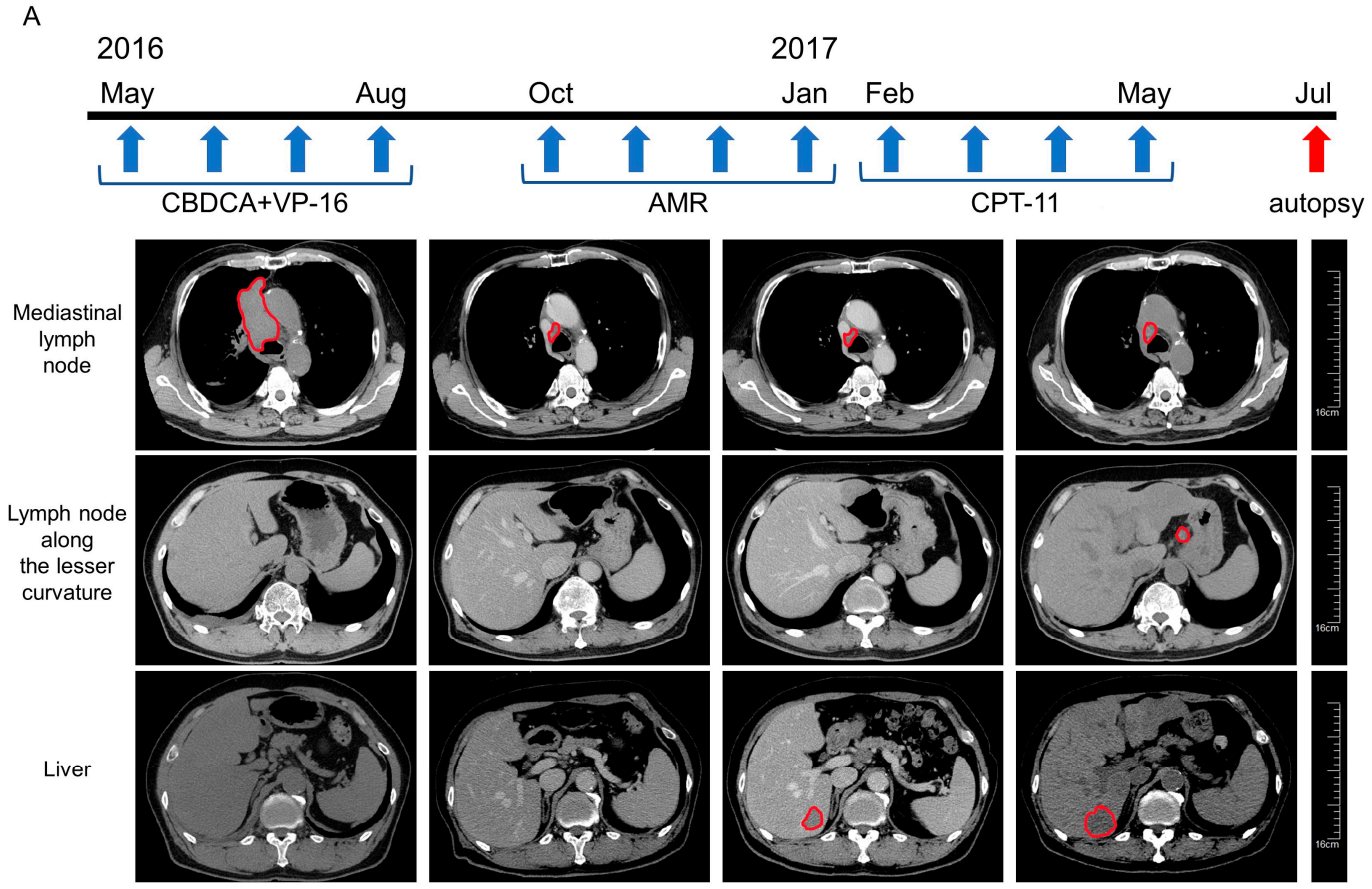
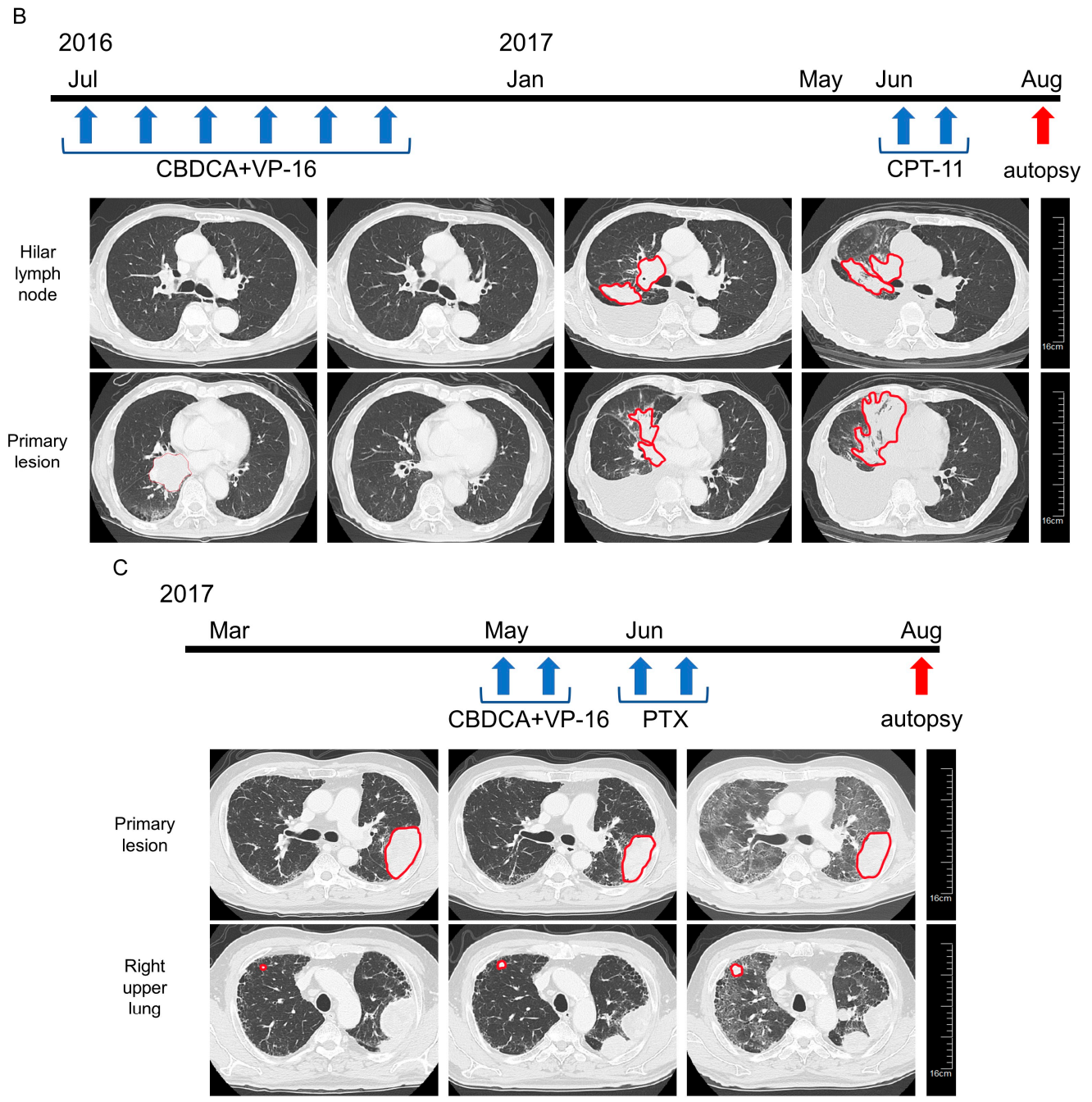
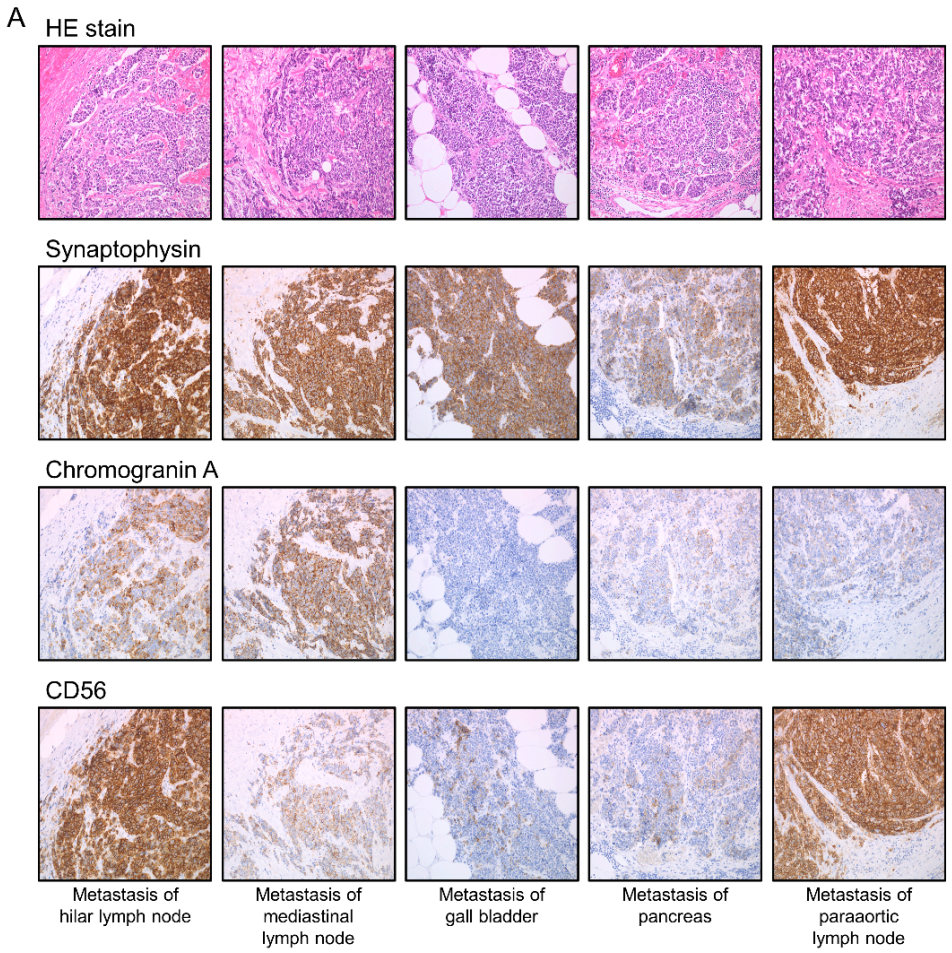

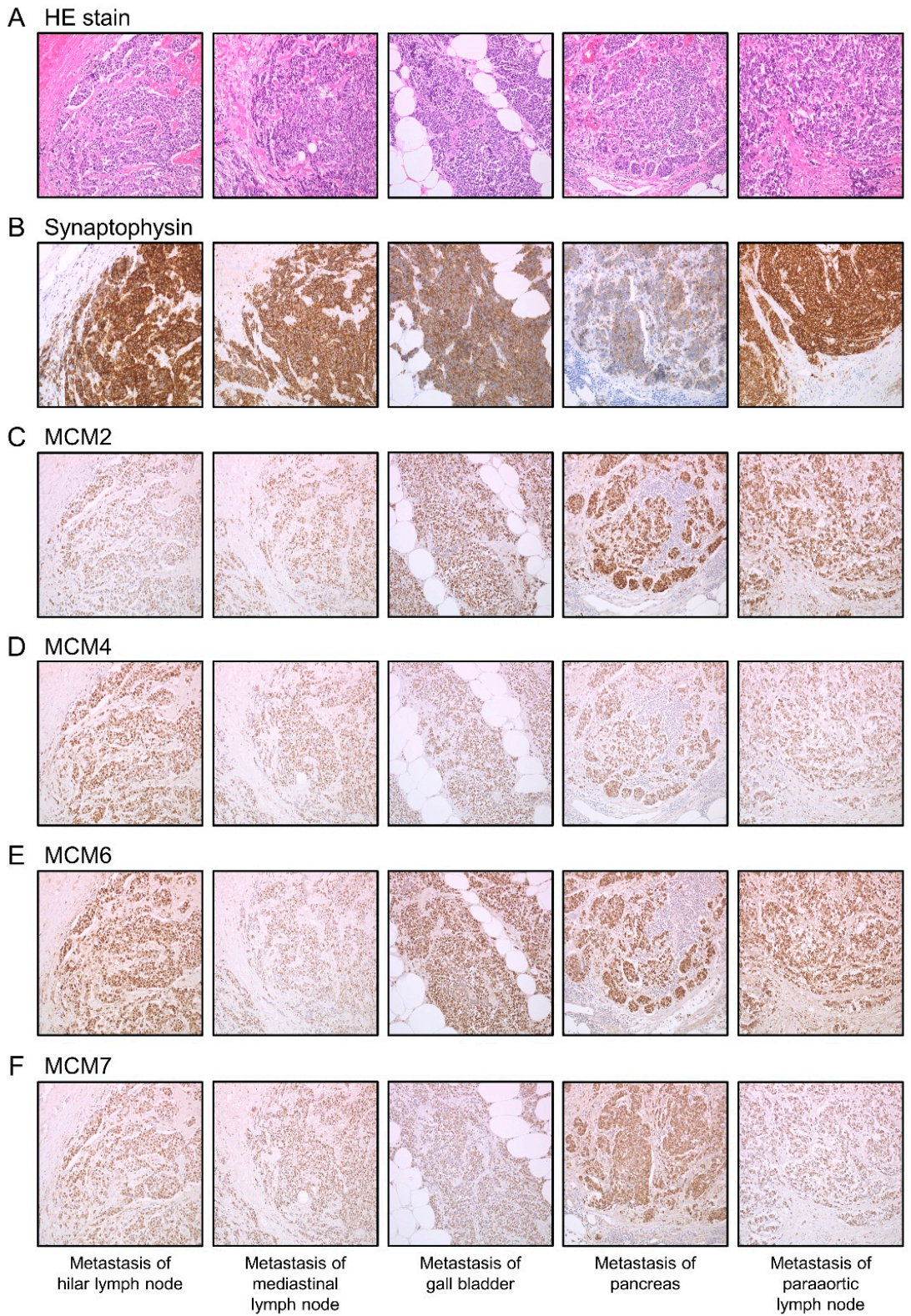
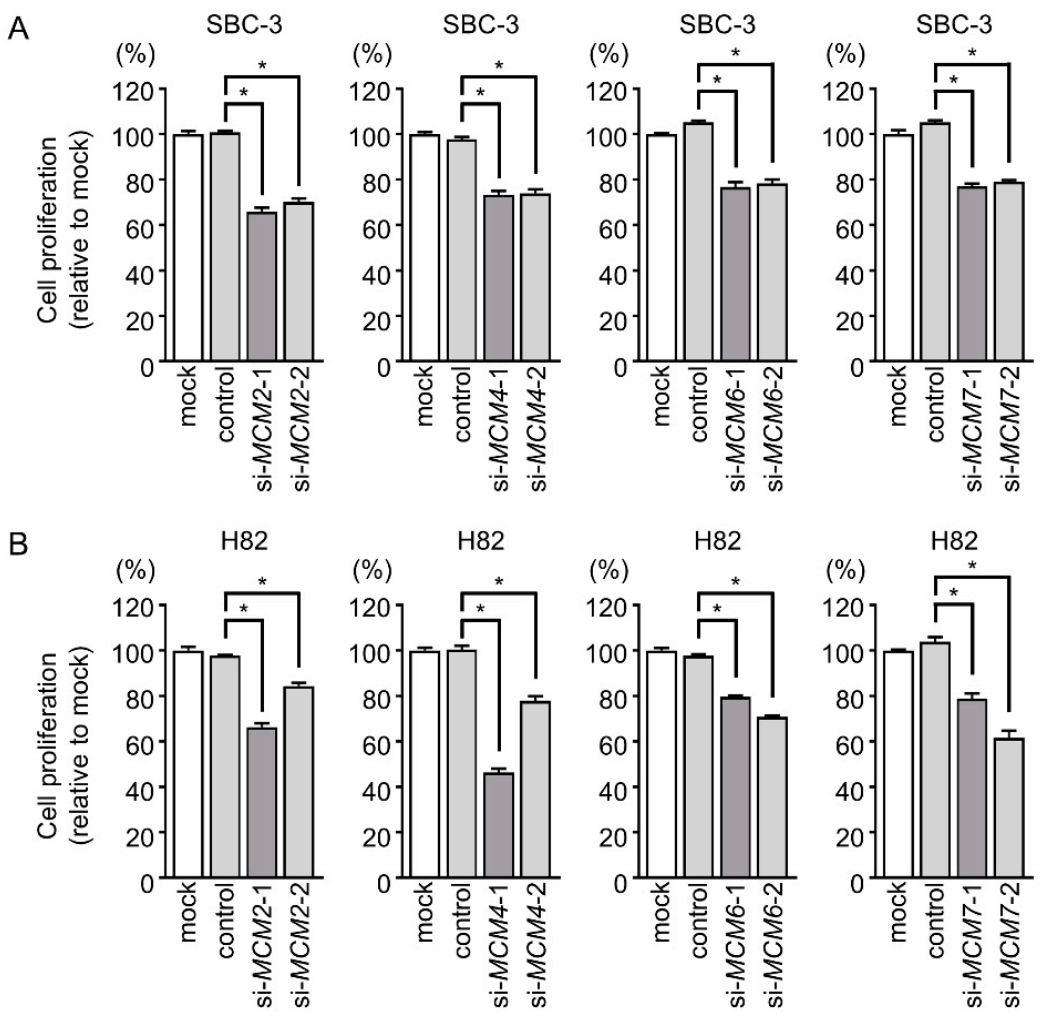

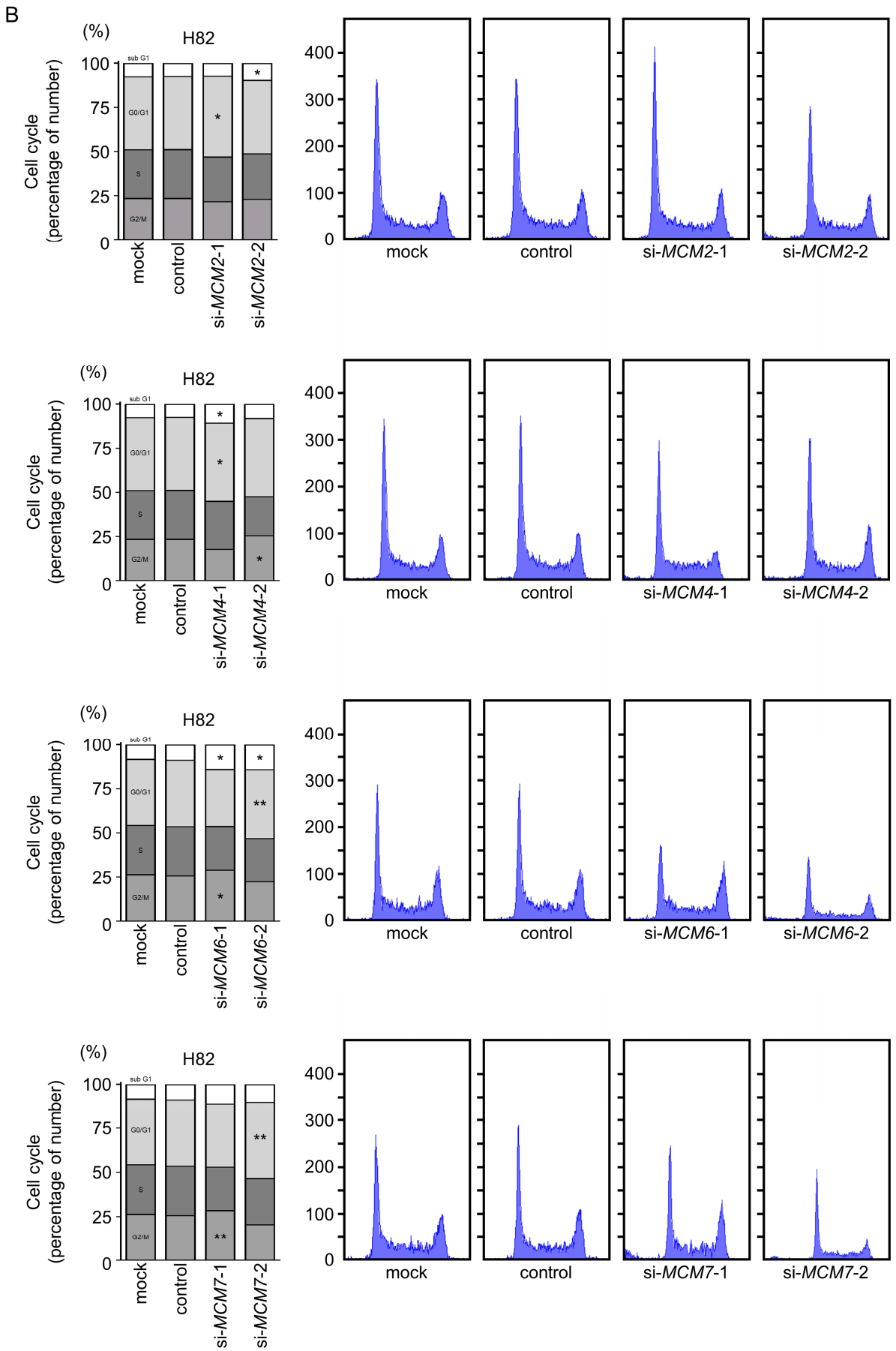
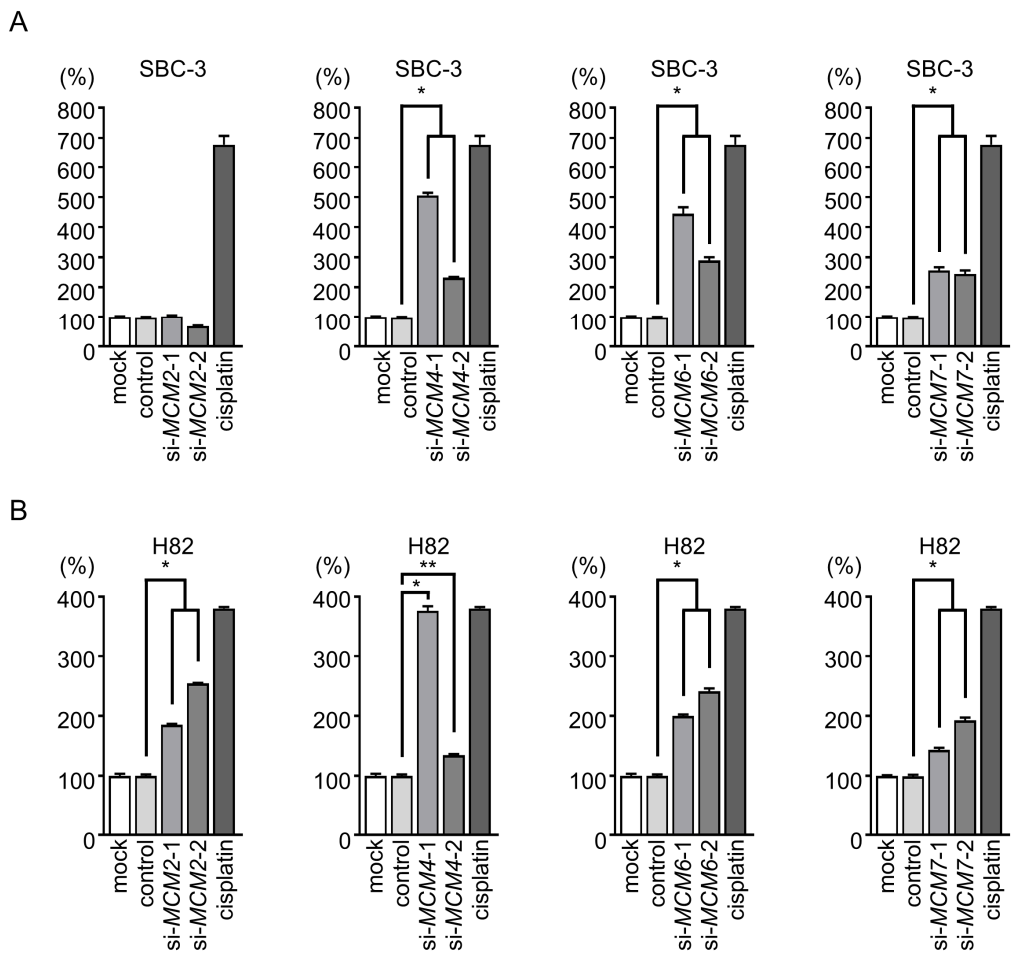

| No. | Sex | Age | BI | T | N | M | Stage | Therapy | Remarks |
|---|---|---|---|---|---|---|---|---|---|
| 1 | M | 67 | 1440 | 4 | 2 | 1b | IV | Platinum based chemotherapy | Microarray expression analysis IHC staining |
| 2 | M | 78 | 1180 | 2b | 2 | 1b | IV | Platinum based chemotherapy | Microarray expression analysis IHC staining |
| 3 | M | 65 | 990 | 2a | 3 | 1a | IV | Platinum based chemotherapy | Microarray expression analysis IHC staining |
| A. Cancer Tissues | n = 8 | |
|---|---|---|
| Sample Name | Tissue | Case No. |
| SCLC-Pri-1 | Primary lesion | 2 |
| SCLC-Pri-2 | Primary lesion | 3 |
| SCLC-Meta-1 | Lesser curvature lymph node metastasis | 1 |
| SCLC-Meta-2 | Mediastinal lymph node metastasis | 1 |
| SCLC-Meta-3 | Para-aortic lymph node metastasis | 1 |
| SCLC-Meta-4 | Right hilar lymph node metastasis | 2 |
| SCLC-Meta-5 | Liver metastasis | 1 |
| SCLC-Meta-6 | Right intrapulmonary metastasis | 3 |
| B. Normal lung tissues | n = 4 | |
| Sample name | Tissue | case no. |
| SCLC N-1 | Normal lung tissue | 1 |
| SCLC N-2 | Normal lung tissue | 1 |
| SCLC N-3 | Normal lung tissue | 2 |
| SCLC N-4 | Normal lung tissue | 3 |
| No. of Genes | p-Value | Annotations |
|---|---|---|
| 28 | 2.28 × 10−12 | (KEGG) 04110: Cell cycle |
| 15 | 9.66 × 10−8 | (KEGG) 03460: Fanconi anemia pathway |
| 26 | 6.19 × 10−7 | (KEGG) 05034: Alcoholism |
| 21 | 2.12 × 10−6 | (KEGG) 05322: Systemic lupus erythematosus |
| 18 | 7.67 × 10−5 | (KEGG) 04114: Oocyte meiosis |
| 10 | 8.54 × 10−5 | (KEGG) 03440: Homologous recombination |
| 9 | 1.92 × 10−4 | (KEGG) 03030: DNA replication |
| 10 | 1.21 × 10−2 | (KEGG) 04115: p53 signaling pathway |
| Normalized Read Count (Log2) | |||||||
|---|---|---|---|---|---|---|---|
| Entrez GeneID | Gene Symbol | Gene Name | Location | Log2 Fold Change | Normal Lung Tissues | SCLC Tissues | p-Value |
| 7272 | TTK | TTK protein kinase | 6q14.1 | 3.67 | −0.37 | 3.30 | 0.0034 |
| 9134 | CCNE2 | cyclin E2 | 8q22.1 | 3.57 | 0.05 | 3.62 | 0.0002 |
| 4173 | MCM4 | minichromosome maintenance complex component 4 | 8q11.21 | 3.33 | 0.20 | 3.54 | 0.0004 |
| 699 | BUB1 | budding uninhibited by benzimidazoles 1 homolog | 2q13 | 3.18 | −0.25 | 2.92 | 0.0040 |
| 701 | BUB1B | budding uninhibited by benzimidazoles 1 homolog beta | 15q15.1 | 3.08 | −0.03 | 3.05 | 0.0018 |
| 9133 | CCNB2 | cyclin B2 | 15q22.2 | 3.05 | 0.05 | 3.10 | 0.0055 |
| 1029 | CDKN2A | cyclin-dependent kinase inhibitor 2A | 9p21.3 | 3.01 | 0.24 | 3.25 | 0.0047 |
| 4171 | MCM2 | minichromosome maintenance complex component 2 | 3q21.3 | 2.96 | 0.01 | 2.97 | 0.0008 |
| 995 | CDC25C | cell division cycle 25 homolog C | 5q31.2 | 2.87 | −0.01 | 2.87 | 0.0045 |
| 891 | CCNB1 | cyclin B1 | 5q13.2 | 2.82 | −0.06 | 2.76 | 0.0008 |
| 1869 | E2F1 | E2F transcription factor 1 | 20q11.22 | 2.82 | −0.30 | 2.52 | 0.0100 |
| 9700 | ESPL1 | extra spindle pole bodies homolog 1 | 12q13.13 | 2.70 | 0.10 | 2.80 | 0.0007 |
| 8318 | CDC45 | cell division cycle 45 homolog | 22q11.21 | 2.64 | −0.29 | 2.34 | 0.0027 |
| 8317 | CDC7 | cell division cycle 7 homolog | 1p22.2 | 2.62 | 0.01 | 2.63 | 0.0006 |
| 4085 | MAD2L1 | MAD2 mitotic arrest deficient-like 1 | 4q27 | 2.61 | −0.19 | 2.42 | 0.0013 |
| 898 | CCNE1 | cyclin E1 | 19q12 | 2.61 | 0.06 | 2.67 | 0.0041 |
| 1111 | CHEK1 | CHK1 checkpoint homolog | 11q24.2 | 2.57 | 0.00 | 2.57 | 0.0088 |
| 993 | CDC25A | cell division cycle 25 homolog A | 3p21.31 | 2.50 | −0.15 | 2.34 | 0.0044 |
| 9232 | PTTG1 | pituitary tumor-transforming 1 | 5q33.3 | 2.40 | 0.07 | 2.47 | 0.0030 |
| 983 | CDK1 | cyclin-dependent kinase 1 | 10q21.2 | 2.40 | 0.05 | 2.45 | 0.0058 |
| 10926 | DBF4 | DBF4 homolog | 7q21.12 | 2.22 | 0.06 | 2.28 | 0.0002 |
| 4176 | MCM7 | minichromosome maintenance complex component 7 | 7q22.1 | 2.20 | 0.13 | 2.33 | 0.0002 |
| 890 | CCNA2 | cyclin A2 | 4q27 | 2.17 | 0.03 | 2.20 | 0.0141 |
| 4175 | MCM6 | minichromosome maintenance complex component 6 | 2q21.3 | 2.05 | −0.11 | 1.94 | 0.0002 |
| 6502 | SKP2 | S-phase kinase-associated protein 2 (p45) | 5p13.2 | 2.04 | 0.23 | 2.27 | 0.0117 |
| 5111 | PCNA | proliferating cell nuclear antigen | 20p13 | 2.04 | 0.01 | 2.05 | 0.0017 |
| 5591 | PRKDC | protein kinase, DNA-activated, catalytic polypeptide | 8q11.21 | 2.01 | −0.03 | 1.98 | 0.0071 |
| 10744 | PTTG2 | pituitary tumor-transforming 2 | 4p14 | 2.00 | −0.01 | 1.99 | 0.0084 |
Publisher’s Note: MDPI stays neutral with regard to jurisdictional claims in published maps and institutional affiliations. |
© 2021 by the authors. Licensee MDPI, Basel, Switzerland. This article is an open access article distributed under the terms and conditions of the Creative Commons Attribution (CC BY) license (http://creativecommons.org/licenses/by/4.0/).
Share and Cite
Misono, S.; Mizuno, K.; Suetsugu, T.; Tanigawa, K.; Nohata, N.; Uchida, A.; Sanada, H.; Okada, R.; Moriya, S.; Inoue, H.; et al. Molecular Signature of Small Cell Lung Cancer after Treatment Failure: The MCM Complex as Therapeutic Target. Cancers 2021, 13, 1187. https://doi.org/10.3390/cancers13061187
Misono S, Mizuno K, Suetsugu T, Tanigawa K, Nohata N, Uchida A, Sanada H, Okada R, Moriya S, Inoue H, et al. Molecular Signature of Small Cell Lung Cancer after Treatment Failure: The MCM Complex as Therapeutic Target. Cancers. 2021; 13(6):1187. https://doi.org/10.3390/cancers13061187
Chicago/Turabian StyleMisono, Shunsuke, Keiko Mizuno, Takayuki Suetsugu, Kengo Tanigawa, Nijiro Nohata, Akifumi Uchida, Hiroki Sanada, Reona Okada, Shogo Moriya, Hiromasa Inoue, and et al. 2021. "Molecular Signature of Small Cell Lung Cancer after Treatment Failure: The MCM Complex as Therapeutic Target" Cancers 13, no. 6: 1187. https://doi.org/10.3390/cancers13061187
APA StyleMisono, S., Mizuno, K., Suetsugu, T., Tanigawa, K., Nohata, N., Uchida, A., Sanada, H., Okada, R., Moriya, S., Inoue, H., & Seki, N. (2021). Molecular Signature of Small Cell Lung Cancer after Treatment Failure: The MCM Complex as Therapeutic Target. Cancers, 13(6), 1187. https://doi.org/10.3390/cancers13061187







